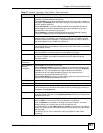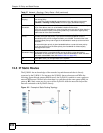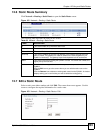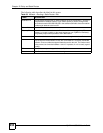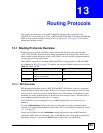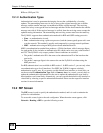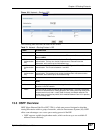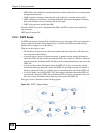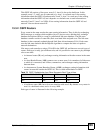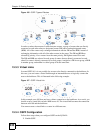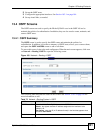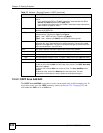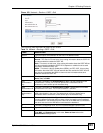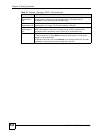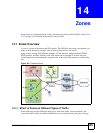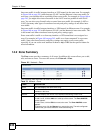
Chapter 13 Routing Protocols
ZyWALL USG 300 User’s Guide
239
This OSPF AS consists of four areas, areas 0-3. Area 0 is always the backbone. In this
example, areas 1, 2, and 3 are all connected to it. Area 1 is a normal area. It has routing
information about the OSPF AS and networks X and Y. Area 2 is a stub area. It has routing
information about the OSPF AS, but it depends on a default route to send information to
networks X and Y. Area 3 is a NSSA. It has routing information about the OSPF AS and
network Y but not about network X.
13.3.2 OSPF Routers
Every router in the same area has the same routing information. They do this by exchanging
Hello messages to confirm which neighbor (layer-3) devices exist, and then they exchange
database descriptions (DDs) to create a synchronized link-state database. The link-state
database contains records of router IDs, their associated links and path costs. The link-state
database is then constantly updated through Link State Advertisements (LSA). Each router
uses the link state database and the Dijkstra algorithm to compute the least cost paths to
network destinations.
Like areas, each router has a unique 32-bit ID in the OSPF AS, and there are several types of
routers. Each type is really just a different role, and it is possible for one router to play multiple
roles at one time.
• An internal router (IR) only exchanges routing information with other routers in the same
area.
• An Area Border Router (ABR) connects two or more areas. It is a member of all the areas
to which it is connected, and it filters, summarizes, and exchanges routing information
between them.
• An Autonomous System Boundary Router (ASBR) exchanges routing information with
routers in networks outside the OSPF AS. This is called redistribution in OSPF.
• A backbone router (BR) has at least one interface with area 0. By default, every router in
area 0 is a backbone router, and so is every ABR.
Each type of router is illustrated in the following example.
Table 72 OSPF: Redistribution from Other Sources to Each Type of Area
SOURCE \ TYPE OF AREA NORMAL NSSA STUB
Static routes Yes Yes No
RIP Yes Yes Yes



